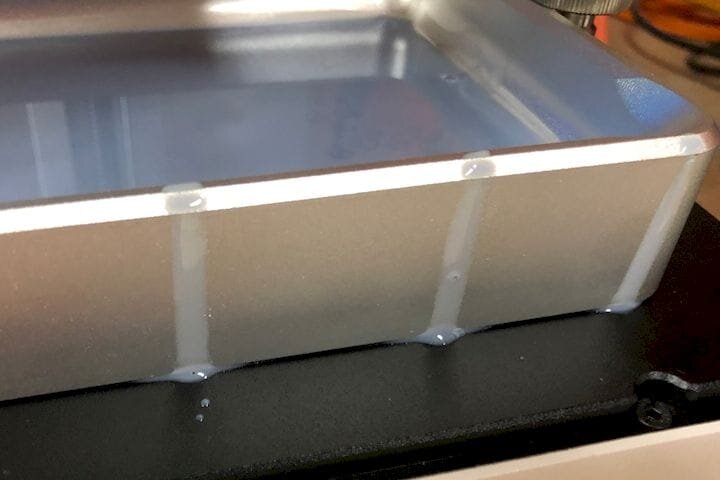![Stray 3D printer resin drips. Toxic, or not? [Source: Fabbaloo]](https://fabbaloo.com/wp-content/uploads/2020/05/image-asset_img_5eb08fe74242f.jpg) Stray 3D printer resin drips. Toxic, or not? [Source: Fabbaloo]
Stray 3D printer resin drips. Toxic, or not? [Source: Fabbaloo]
This week’s question is from reader Simon, who is quite concerned about resin 3D printer safety.
Simon asks:
“I am currently thinking about getting a resin 3D printer (probably the Anycubic Photon). As this will be my first resin printer, I am concerned if the resin fumes are toxic. I found your articles about the toxicity of resin very interesting and hope that you could give me some insight about the toxicity of the resin fumes as well. Is it enough to air the room after a print? Or do I need a dedicated room for printing or even some kind of air filtration system?”
3D Printer Ventilation
It goes without saying that every 3D printer installation, regardless of whether it is resin, powder or filament, should have a ventilation solution. This would remove airborne particles and volatile organic compounds (VOCs) from the workshop.
Ventilation can be accomplished by literally venting air to the outside, or by using a filtration system if there is no physical opportunity to vent outside. These are standalone devices holding a complex of filters that (hopefully) capture particles and VOCs.
But resin 3D printers pose another problem: touch.
Touching 3D Printer Resin
There’s no problem in handling filaments, at least until someone invents a radioactive filament (no, please don’t!) But resins pose some unique challenges.
I should point out that there are countless different resin variations, each with a unique combination of base chemicals. This is how the resins acquire different engineering properties, but it’s also how to make them all different, chemically. Thus exposure to a given resin could have different effects than another.
There is a general pattern, however, with liquid resins. The issue seems to be the absorption of the resin chemicals into the body.
3D Printer Resin MSDS
One approach you might consider is reviewing the MSDS (Material Safety Data Sheets) that are supposed to be included with every material, including resins. However, in practice some vendors of 3D printer resin don’t always provide the MSDS documents. Others may present the documents, but they may not be certified. And few of them deal with the repeated exposure effects described below.
The fact is that we really don’t know specifically what happens in the long term, simply because there don’t seem to be substantial investigations of 3D printer resin safety. There have been a few studies done on filament 3D printing, which is how we know about nanoparticle and VOC emissions. I am not aware of any corresponding studies on 3D printer resin, and it’s likely going to take a few years for that to happen.
3D Printer Resin Allergic Response
It seems that over time if a body absorbs a sufficient amount of certain chemicals, it will naturally develop an allergic response. This has been seen in many different substances, and resins can carry quite a few. I’m told this allergic reaction can develop quite suddenly, and render a person unable to continue working with the material.
Thus a drip on a finger is usually not immediately dangerous; rather it is regular exposure to the body.
The game here is to minimize the touch exposure. The key tool in this regard is the use of disposable nitrile gloves, used exactly once per print job.
These gloves keep the skin from being exposed to resin. However, if, as usually happens, resin is spilled on the skin accidentally, it should be washed off immediately with cold water. Hot water would tend to open pores on the skin and allow chemical entry.
3D Printing Toxic IPA
Another complication is the use of IPA to clean resin 3D prints. Typically a resin 3D printer setup involves the printer and a pail of IPA. The fresh, drippy prints are placed in the IPA and agitated for a time to dissolve the resin clinging to the surface of the print.
The IPA usually does a good job, but where, exactly, does the resin go? It’s dissolved in the IPA! You may notice the normally clear IPA acquires a color after cleaning prints. That color is the resin.
And at that point your IPA cleaning station is essentially a toxic solution of resin and IPA. IPA is also itself a dangerous substance, and if used on the skin directly it can open pores and allow more or less direct access to the bloodstream. Thus, the cruddy IPA cleaning station is perhaps the most dangerous material in a resin 3D printer configuration.
Back to Simon’s question, which asked whether the fumes were toxic. I presume they could be, but they are relatively easily dealt with through ventilation. The real issue is touching the resin.
Just don’t.
If you have a question about 3D Printing, ask us!

